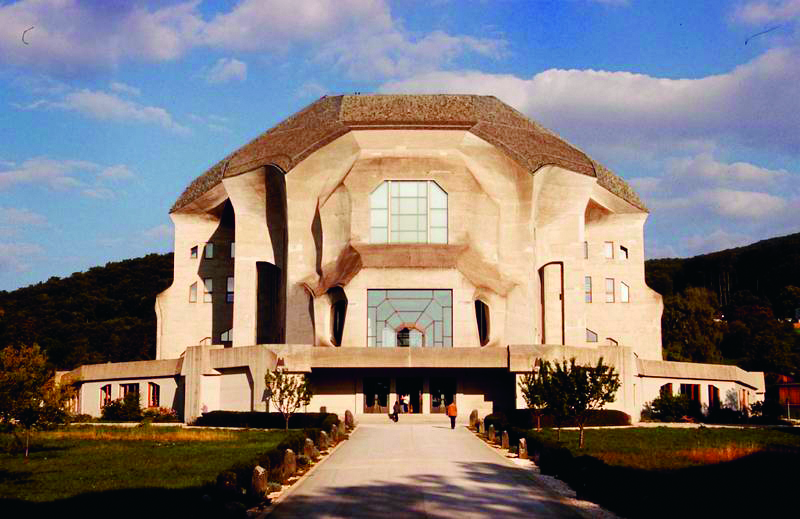
The Goetheanum in Dornach SO was constructed in the 1920s according to Rudolf Steiner’s architectural theories. Since then, it has been the seat of the worldwide Anthroposophical Society.
Before finding ourselves lost in convoluted semantics, let’s attempt to find some definitions. According to Wikipedia, spirituality means the quest for and experience of a rationally inexplicable reality.
It encompasses religion and occult creeds. Esotericism, likely synonym to mysticism, implies the existence of an ethereal spirit world. Now, you may ask yourselves: What is the difference between esoteric and religious beliefs? Good question. The belief in deities is not necessarily found in esoteric teachings but is associated closely with religion. Instead of gods, there is often a deified spiritual leader who first preached his thoughts to the world – which sounds an awful lot like Buddhism.
It appears like religion, being such a broad concept, can attain all sorts of meanings. Here, I must admit my defeat and propose that religion and esotericism go hand in hand.
Russel’s analogical teapot
The idea of writing an article on esotericism came to me after discussing the British philosopher Bertrand Russel’s teapot analogy with friends. Russel postulated a teapot to be orbiting the sun; too distant to spot with a telescope. Further, he claimed the teapot’s existence could not be disproven, since any investigation would be impossible. Through his analogy, he aimed to show the falsity in needing to disprove beliefs which lack empirical evidence. Thus Russel, being an atheist, openly criticised religion. While the teapot argument is rhetorically flawless, Russel received flak from other philosophers for rejecting religion too hastily. Similarly, downplaying mysticism as humbug cannot be taken for good philosophy. Strong spirituality shared by a group of humans seemingly moves beyond the logic of validation and dismissal. It gets even weirder when physical effects suggested by esoteric belief collide with objective reality. To develop these thoughts further, Europe’s largest esoteric movement called anthroposophy will now be taken as a case study.
The story of Rudolf Steiner
In the wake of the industrial revolution in Germany, a Goethe scholar named Rudolf Steiner began writing about his clairvoyant experience and spiritual train of thought. Although he failed to achieve academic philosophical recognition, his works reverberated through German esoteric minds. Steiner, being a talented leader, quickly gathered supporters and founded the Anthroposophical Society. His teachings combined, among others, German classical philosophy, Christianity, Indian mystical teachings and natural science. Truly, he was a jack-of-all-trades who not only founded a religion, but also developed pedagogical concepts and wrote on agriculture, medicine and even architecture. Citing Wikipedia once again: Steiner postulated the existence of a comprehensible spiritual world accessible to human experience. Apart from their material bodies, humans and animals bear prana-like etheric bodies and astral bodies akin to souls. The anthroposophical approach would allow to grasp this spiritual world which eludes natural science as it cannot be physically perceived. After his death, Steiner’s society continued to grow and nowadays finds itself rooted deeply in the German-speaking area.
Anthroposophy among cabbage
Let me present two curious cases where anthroposophy meets reality, starting with agriculture. Fresh produce sold under the Demeter label can be found not only in organic grocery shops, but also at Migros and Coop. Named after the Greek goddess of agriculture, Demeter is an association founded shortly after the Anthroposophical Society’s conception. First and foremost, the association promotes modern biological agriculture and ethical animal husbandry according to strict guidelines. Unlike other organic labels, Demeter’s agricultural procedures are not only based on environmental research, but also on theories of biodynamic farming coined by Steiner. Farmers working in adherence to biodynamic principles must use special preparations such as horns filled with dung and minerals to vitalise their fields by concentrating cosmic vigour. Though these practices miss any scientific basis, a long-term study led by Dr Paul Mäder of the ETH has found biodynamically cultivated soil to be more vital than its conventional equivalent.
Schools which promote creativity
The second well-known application lies in the field of education. Rudolf Steiner was once requested to found a school for the children of Waldorf-Astoria cigarette factory worker. This original later served as a model for a hundred dozen similar private institutions across the globe. Nowadays, they are known as Waldorfschule in Germany and Rudolf Steiner Schule in Switzerland. Due to their low-pressure study environments which lack strict gradings and instead focus on arts, handicrafts and music, they have shown that successful education may be achieved without pressuring children to perform. However, it is often overlooked that these school’s pedagogical concepts are partly based upon esoteric theories instead of social science.
A contradiction of perspectives
To conclude this essay, I would like to give you some food for thought. Since coming into existence, anthroposophy has been critiqued for its pseudoscientific nature seeing that it often lacks evidence or is based upon outdated theories. Waldorf primary teachers are still taught the four temperaments theory in accordance with Steiner to better understand children’s personalities.
However, modern psychology has long since discarded the four temperaments. Now, does scientific objectivity have the right to declare esoteric theories such as Steiner’s invalid when they deviate from or outright contradict empirical results and proven theses? I thoroughly reckon that it does. While anthroposophy has brought many ideas of reform, some of its aspects, such as the pseudoscientific ones, demand revision or transparent contextualisation.
Arthur Odnoralenko, 20,
Environmental Engineering BSc, feels drawn to controversial discussions and admits to shamelessly plagiarising Wikipedia.

